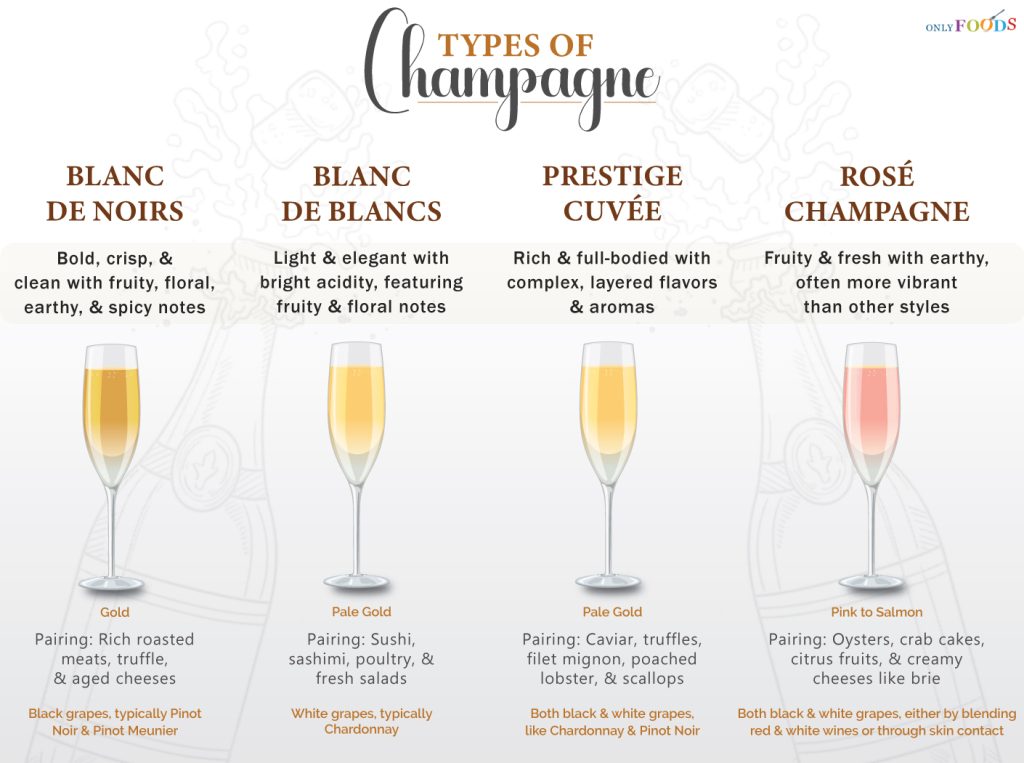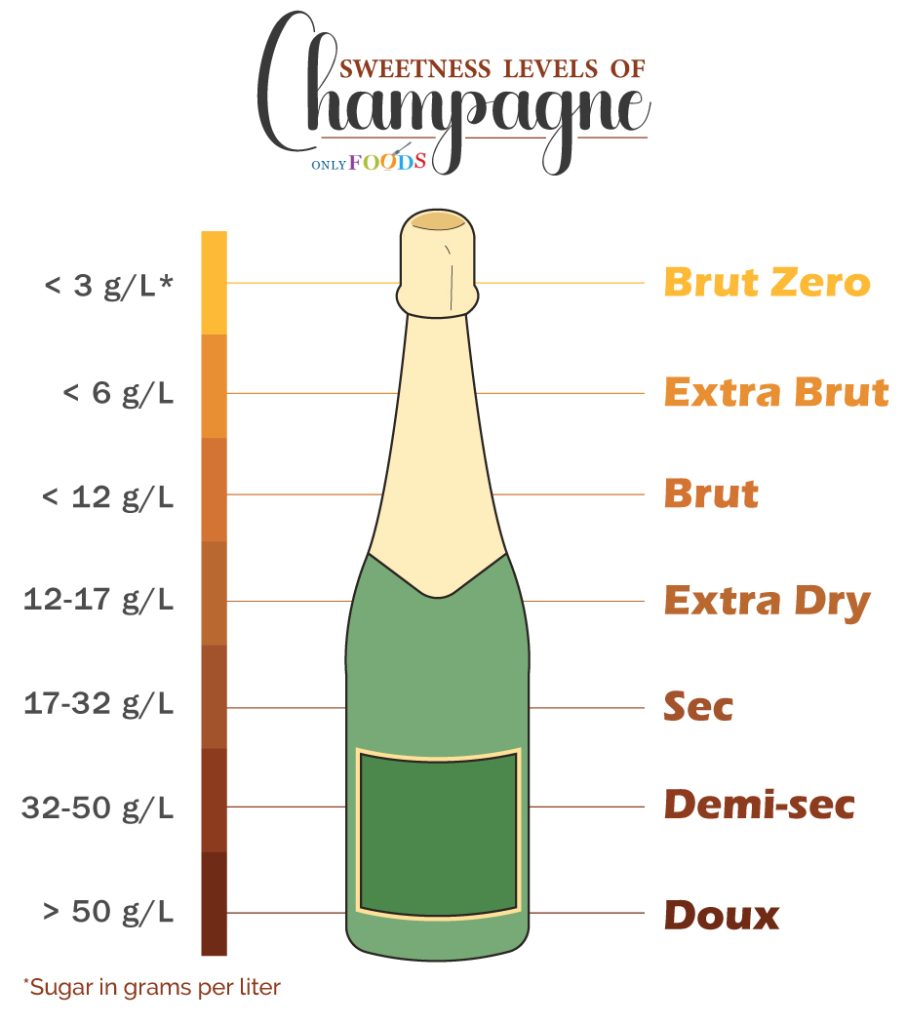Types of Champagne
Champagne is a sparkling wine produced exclusively in the Champagne region of France. It adheres to strict appellation rules, meaning that only sparkling wine from this specific area can be labeled as “champagne.” More than just an alcoholic drink, it symbolizes luxury, elegance, and celebration—no wedding or New Year party would be complete without popping “a bottle of bubbly.”
Despite being a type of wine, champagne comes in a variety of styles based on factors like aging time and sweetness. The exclusive region, labor-intensive production methods, strict quality standards, and luxury branding all contribute to making champagne one of the most expensive alcoholic beverages.
As a type of wine, champagne typically has an alcohol by volume (ABV) between 12-12.5%, although the ABV for wines in general can range from 5-16%.
Production and Classification of Champagne
To be officially labeled as “champagne,” manufacturers must follow the traditional method known as “méthode champenoise.” This process involves several key steps:
- Sourcing Grapes: Grapes are sourced from designated vineyards within the Champagne region in France.
- Producing Base Wine: The harvested grapes are fermented to create a still base wine.
- Secondary Fermentation: The base wine is then bottled with a mixture of sugar and yeast (brewer’s yeast or Saccharomyces cerevisiae) to undergo a second fermentation. This process is similar to that used for other sparkling wines; the carbon dioxide produced during fermentation is trapped in the sealed bottle, creating the characteristic bubbles of champagne.
- Aging: After the second fermentation, the champagne is aged. Standard regulations require a minimum aging period of 1.5 years.
- Riddling and Disgorgement: After aging is complete, the dead yeast cells (lees) are removed through riddling, a process in which bottles are gradually tilted and turned to collect the sediment in the neck. This is followed by disgorgement, where the neck is frozen, and the trapped yeast plug is expelled.
The primary classification of champagne varies based on aging, grape varieties used, and levels of sweetness.
Classification Based on Aging
1. Vintage
This is a style where at least 80% of the base wine must be made from grapes harvested in one specific year, which is indicated on the label. Only years with optimal growing conditions are deemed suitable for vintage production. As a result, vintage wines have limited availability, making them expensive.
Aging: At least 3 years
Flavor profile: Pronounced taste, flavor, and aromas that showcase the characteristics of that year’s climate, soil, and grape varieties.
2. Non-Vintage (NV)
This style refers to champagne made with wines from different harvest years. This means the grapes that go in a non-vintage wine come from different harvest years. In most cases, it contains some vintage wine from the same year, blended with reserve wines from previous years. It makes it easier to maintain the same flavor profile while making the champagne more widely available and affordable.
Aging: At least 1.5 years
Flavor profile: A balance of fruity, floral, and spicy notes, with the flavor of a product remaining consistent through the years.
Based on the Types of Grapes Used
As already mentioned, the grapes are harvested from specific vineyards. Pinot Noir, Chardonnay, and Pinot Meunier are typical choices for champagne production. Here are the types of champagne based on what grapes are used in their production, along with what sets them apart and what to pair them with:
| Name | Types of Grapes & Base Wines | Body, Aroma, Flavor Profile | Food Pairing Ideas | |
|---|---|---|---|---|
| Blanc de Noirs | Color: Light to deep gold | Black grapes, usually Pinot Noir and/or Pinot Meunier | Bold, crisp, and clean with fruity, floral, earthy, and spicy notes; often more intense and full-flavored than Blanc de Blancs. | Rich foods, like roasted meats, truffle, aged cheeses, and charcuterie. |
| Blanc de Blancs | Pale gold | White grapes, typically Chardonnay | Light and elegant with bright acidity, featuring fruity, citrus, green apple, and floral notes. | Light seafood (sushi, sashimi, scallops), poultry, fresh salads, and creamy dishes like risotto. |
| Prestige Cuvée | Pale gold | A blend of the finest black and white grapes, often Chardonnay, Pinot Noir, and Pinot Meunier | Rich and full-bodied with complex, layered flavors and aromas that vary based on the blend and can range from spicy and nutty to citrus, fruity, toasty, and brioche. | Exquisite dishes like caviar, poached lobster, scallops, truffles, fine meats (filet mignon), aged cheeses, and other gourmet appetizers. |
| Rosé Champagne (“pink champagne”) | Pink to salmon | Both black and white grapes. Made either by blending red and white wines or by allowing the grape skins to stay in contact with the juice for a short period during fermentation. | Fruity & fresh with earthy aromas. Often more vibrant than the other styles. | Creamy cheeses like brie and camembert, seafood (oysters, crab cakes, grilled salmon), citrus fruits, light vegetable salads, and charcuterie. |
Based on the Level of Sweetness (Dosage)
As the last step of champagne production, a mixture of cane sugar and wine, together referred to as “dosage,” is added to the bottle following the removal of the lees by disgorgement. It balances the levels of sugar in the finished champagne when bottled for sale.
| Name | Added Sugar (g/L) | Most Suitable in |
|---|---|---|
| Brut Zero | < 3 | Fresh and light cocktails (e.g., Spritz) |
| Extra Brut | < 6 | Crisp cocktails (e.g., Classic Champagne Cocktail) |
| Brut | < 12 | Versatile cocktails (e.g., Mimosa, Bellini) |
| Extra Dry | 12-17 | Fruity cocktails (e.g., Kir Royale) |
| Sec | 17-32 | Dessert cocktails (e.g., Sweet Champagne Punch) |
| Demi-sec | 32-50 | Dessert and fruit-forward cocktails (e.g., Champagne Mojito) |
| Doux | > 50 | Dessert cocktails (e.g., Sweet Sparkling Sangria) |
Though at present, champagne is not expected to be sweet, historically, it was considered a dessert wine and hence was much sweeter. For example, goût américain or “American taste” champagnes had 110-165 g/L sugar, while Goût français or “French taste” had 165-200 g/L, and Goût russe or “Russian taste” had 200-300 g/L sugar.
FAQ
Although champagne is a type of sparkling wine, the terms are not interchangeable. Champagne specifically comes from the Champagne region of France, while other sparkling wines, such as Prosecco from Italy and Cava from Spain, are produced in different regions using varied methods. Therefore, while all champagne is sparkling wine, not all sparkling wine is champagne.
Champagne typically contains about 80 to 120 calories per 5-ounce (150 ml) serving. The exact number can vary based on factors like the sweetness of the champagne. For example, brut champagne generally has fewer calories than sweeter varieties, such as demi-sec or doux.
As it is made from grapes, champagne, like most other wines, is naturally gluten-free. It is still advisable to check the label to make sure there are no additives or flavorings containing gluten.


